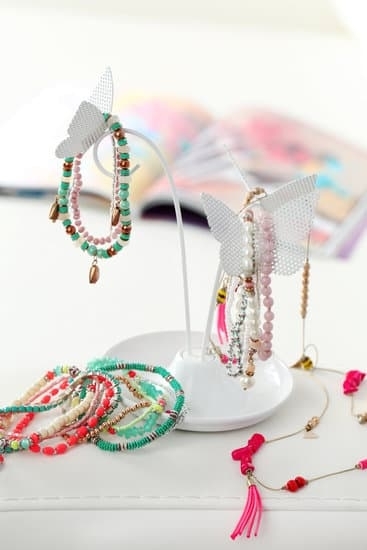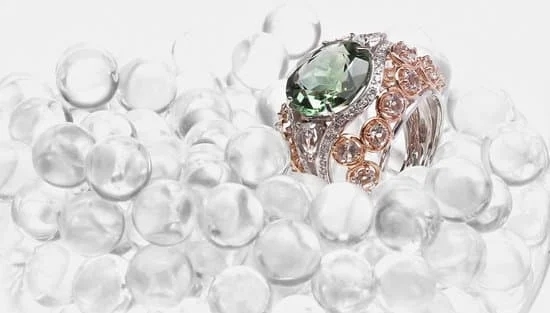Victorian Era men’s jewelry allowed men to feel more comfortable expressing themselves. As with most objects of fashion, designs became increasingly elaborate and ornate as the Victorian Era unfolded. It was during this time that the “dandy” culture emerged, and mens jewelry became an extension of their well-groomed and personal appearance.
Victorian era men’s jewelry showcased intricate carvings, attention to detail, quality craftsmanship and exotic materials such as ivory, tortoiseshell and precious gems. While modern men’s jewelry tends to be simple in design featuring metals such as gold or silver, Victorian era men’s jewelry was defined by ornately carved motifs including garlands, swooping curves, floral designs and inlaid stones.
While today we almost exclusively think of Victorian Era Men’s Jewelry as being worn on the hands and fingers (rings & signet rings), it was not uncommon for gentlemen of the day to accessorize with elaborate neckwear. This ranged from large statement necklaces featuring a variety of stones set in intricate patterns to daintier gold lockets which were often gifted from wife to husband in token of their love or respect.
Brooches were also popular items: ranging from small pendant brooches up to sprawling shoulder-width pieces that featured ivories or other rare materials in the design.
Additionally hat pins were seen a lot throughout the century – initially crafted using stone and metal filigree, these pins reflected the wearer’s status or membership in different scholarly societies – though by later years simpler handcrafted gold pins had become popularized publicly signaling both a style icon but also a subtle status symbol as only those with resources could afford them at the time.
Finally cufflinks were commonly found amongst gentlement’s attire; they took on many forms – frequently sporting initials or family crests along with ornamental shapes & designs crafted out of gems such as diamonds paired with enameled metals like silver & gold-plated copper or brass – each with detailed attention to form & scale that was characteristic of this period’s beautiful artistry & craftsmanship.
In conclusion it is evident that when compared to modern day mens’ jewellery choices ,Victorian Era Men’s Jewellery can be identified through its distinct characteristics unique detailing ,ornate carvings ,use of gemstones & exquisite craftsmanship.
Historical Context
The Regency period in the United Kingdom was a time of great change and upheaval, with many fashion trends coming and going. Men’s clothing primarily consisted of tailored three-piece suits, often hunting or frock coats for formal occasions. Accessories such as pocket watches, buckles and pins were essential additions to the outfits of dapper gentlemen during this era. Jewelry for men was not popular but rings were used to signify importance or allegiance to a family.
When Queen Victoria began her long reign from 1837 until 1901, men’s fashion changed drastically. Muscular physiques seemed to be the goal during this era with flamboyant colors, fabrics and accessories now encouraged. Neckties made their way onto the scene and brooches, cufflinks and waistcoat watches became popular items among highly fashionable men.
Rings became more used than before, but now they showed the wealth of the gentleman wearing them with ornate designs set with diamonds, rubies or other valuable stones. Many military officers would proudly wear regimental jewelry to show they had fought in battle so these pieces also came into style although they remained only accessible by those that could afford them.
This trend in ostentatious attire continued through the late Victorian period when lighter colors started becoming more acceptable for social occasions as well as eveningwear; waistcoats took on floral designs or intricate embroidery depending on the occasion.
When it came to jewelry from this era neck crests were briefly fashionable when paired with mismatched buttons along shirt fronts plus watch fobs hung from multiple chains and brooches featuring initials or family coat-of-arms all combined together made for quite a distinguished look.
Types of Jewelry
The Victorian Era men’s jewelry was indicative of the wealth and social standing. There were three distinct types of jewelry worn by men during this time: upper-class, middle-class, and lower-class fashion.
For the upper and wealthy class, complex pieces such as necklaces and earrings made with precious stones and metals were popular. Gold watchcases, keys, seals and which bore a family crest or initials could also be found in their wardrobe. These intricate items of jewelry served as a symbol of their power and prestige. Some of these items may have been part of an inheritance passed down through the generations.
The middle class often wore more subtle pieces such as lockets, tie pins and cuff links. These items were generally made from simple gold or silver without precious stones or additional details. Although not as extravagant as those sported by the upper classes, they still indicated one’s status due to their rarity. Pocket watches too were popular amongst the affluent members of this tier of society; intended for everyday use, yet still a signifier of wealth in its day.
Lastly, the simpler pieces worn by those in the lower classes expressed a different impression entirely – often crafted out of clay or wooden beads to reflect regional styles or decorative perforations made in metals like copper or brass buttons to be worn on clothing as badges.
Although they may not be seen as costly items today these pieces would have been meaningful investments for their wearers – offering an inexpensive but way to display their identity in society at large due to their affordability.
Symbolic Significance
The Victorian era was one that placed high importance on style and material goods as a means of social dominance. Men’s jewelry was especially important during this time due to its symbolic significance. Collections included signet rings, lapel pins, chain link necklaces, pocket watches, and fob – or stickpins. Commonly used materials such as gold, silver, and rose cut diamonds were also symbolic of wealth and power.
Signet rings were a popular jewelry item among males during the Victorian era, indicating they were members of the elite nobility class or aristocracy. The engravings on these rings would represent a certain crest or motto associated with the wearer’s family line.
Lapel pins were also common among the upper class men; although smaller in size than their ring counterparts, these pins could be just as ornate with intricate designs featuring a variety of motifs including birds, skulls, snakes, stars, sea creatures etc. Symbolizing loyalty and reliability to one’s beliefs and values this piece was also indicative of status amongst peers in society.
Chain link necklaces became popular toward the end of the Victorian era for men but still held strong symbols associated with it – primarily beauty and wealth. Gold chain links usually denoted married male status while silver chain linked necklaces generally indicated an unmarried man or bachelor since gold was more expensive at that time period thus giving extra meaning to ones marital status.
In addition to wedding bands pocket watches were often gifted during Victorian times by family members or significant others as an added signifier of love and eternal connection between two people.
Lastly stickpins made an appearance in both lapel buttons on French coat styles and also in smaller tie versions which allowed men even more options when it came to outward expression of personal tastes. In addition to being fashionable these pieces added discreet notes of individuality while simultaneously conveying classiness exhibited through carefully chosen styling details like precious gemstone embellishments etcetera.
Popular Materials
The Victorian era was a period of elegance and luxury, with many members of the upper class adorning themselves in expensive jewelry. This included gold and silver pieces, but there were far rarer materials used to craft unique accessories. Jewelers often experimented with precious stones like rubies, sapphires, and diamonds to create dazzling displays.
Techniques such as etching, engraving, and embossing added complexity to the pieces or showcased intricate floral patterns. Even so-called “hard”stones, such as agate, jasper and malachite, were made use of in order to give jewelry a truly exotic appeal.
Many men from the Victorian era also chose to don more plebian accessories like charms or medallions crafted from iron or brass. These metals could take on a variety of hues depending on the alloying process used by the craftsman.
Smooth surfaces made for beautiful sculping work in which abstract shapes were formed from malleable material – a task which required undivided attention and steady hands. Iron molds might also have been employed to create an impression rather than advanced engravings being used – this could allow jewelers to cast brooches without having much prior experience in working with metal alloys.
Aside from personal symbols or religious icons that might be found on necklaces heirloomed through generations; other potentially common emblems included medals given out for military service or gilded letters that denoted membership within specific clubs or organizations. These fashionable ideals allowed men of all socioeconomic backgrounds to join together under one roof while posing as equals during meals – courtesy of each man’s individual jewelry choices.
Necklaces would typically hang low along waistsline with large pendants laying against fabric shirt folds – adding complexity and dimensionality when combined with looser fitting clothing items again popular during that era.
Ornamental Designs
The Victorian era was a period of blossoming fashion that changed lifestyles and the ways people expressed themselves. One of the most iconic finds during this period were Men’s Jewelry. Women weren’t the only ones getting jeweled up, and many men wore jewelry to make a statement about their wealth, prowess and status in society.
Jewelers during the Victorian period had different approaches to creating alluring pieces. Some opted for intricate ornamental designs while others focused on distinct sets that focused on blends of materials like silver, gold, stones and pearls.
While these materials remained timeless throughout the decades, there were specializing techniques used to bring these designs to fruition including engraving images upon them, setting gems into them or adding enamel paint for added definition and colour. Each technique provided a different aesthetic that could be changed depending on the man’s personal taste or desired look; making it easier for him to express himself through ornamentation without having to utter a word.
In addition to showing off his newfound style and affluence, jewelry worn by men during the Victorian era helped attract potential mates as well-ultimately giving his life more meaning than previously thought possible before this trend began occurring. Now rather than concealing themselves from society due to shame or insecurity, men could have an opportunity to further their career prospects as well as find love at their fingertips in unexpected ways with such sparkly and entrancing pieces of bling.
The Victorian era indeed created history when it comes down to men’s fashion in its own way–effectively solidifying its legacy for centuries since then.
Popular Styles
The Victorian era was an influential period spanning from 1837-1901 in British history dominated by the reign of Queen Victoria. During this time, many aspects of daily life-including fashion-shifted notably, as the economic boom brought forth new ideas and styles. In particular, men’s jewelry during this period clearly showed this influence with unique brooches, signet rings and watch chains adorning their attire.
Many of the popular styles during this era contained much symbolism behind them to express art and beauty. Brooches such as those constructed from gold or silver offered much intricate detailing such as floral design elements that highlighted their beauty even further. Men were known to pair these pieces with a formal tie or waistcoat for a truly distinguished look. Additionally, curling lockshapes served both as a mockery against Victorian social conventions and to represent symmetry among otherwise uncomfortable styles.
Finger rings with intricate symbolism were also popularized during this time period. Signet rings contained initials of the wearer that appeared prominently on its face and were used for personal identification purposes. This conveys how significantly style was used for expressing authority and respectability among peers in the Victorian era. Furthermore, various metals often contained engravings or black enameling that far surpassed the basics of current fashion trends while still encompassing luxury into everyday life throughout Britain.
Aggressive masculinity inspired many popular watch chains during the Victorian Era due to their unique looks unrivaled by anything seen prior to this point in time. Composed of classic gold or silver, along with other valuable metals like platinum – being introduced then – they incorporated elaborate link designs through heavy craftsmanship while often paired with large fobs that would hang prominently from pockets; serving both style purposes along with practicality too by containing elements like pocket clocks hidden inside them.
Such pieces exuded impressive sophistication from individuals wearing them regardless of class status – albeit wealth eventually found its way into the equation at times too.
Overall, men’s jewelry in the Victorian era embodied power and desirability among those who wore it due to its focus on intricate symbolism that served to display artistry amongst complex fashion statements unlike anything else before it.
Legacy
The influence of Victorian Era men’s jewelry is strongly evident in the modern fashion industry. The Victorian Era, known for its romanticism and classical ideals, was a period that focused heavily on decorative accoutrement of the body. Jewelry served as both a symbolical expression of wealth and status, as well as a storytelling tool for one’s individual journey or narrative. The ‘gentleman’ especially valued accessorizing with rings, cuff links, chains, stickpins and watch fobs.
These items were crafted from various metals such as gold or silver and could be further ornamented with precious stones or inscriptions. Depending on the lifestyle of the particular wearer they might have more elaborate pieces than another who had less means – collecting jewelry during this period was deemed an important display of masculinity and high style.
As such, several designs have re-emerged time-and-time again in modern men’s jewelry collections; congruent ideals remain incredibly relevant even now.
We see this reflected today by vintage or antique jewelry becoming increasingly popular among males; these pieces bear with them a sense of tradition while also allowing an individual to express themselves more deeply being donning physical relics from generations past. In addition to rings, cuff links and pocket watches are making waves on the red carpets amongst our current A-list celebrities.
Popular streetwear designers including Kalen Jordan and Pieces by Guru follow similar motifs , utilizing iconic signifiers from Victorian Era jewelry to define unique identities for their customers through customized accessories.
Furthermore, due to its increasingly rare availability, vintage or antique jewelry has become integrated into investment portfolios , demonstrating the enduring relevance it has retained throughout time. We can see clearly how our adoration for items from the Victorian Era continues on even until today in our love for timeless menswear pieces and accessories.

Welcome to my jewelry blog! My name is Sarah and I am the owner of this blog.
I love making jewelry and sharing my creations with others.
So whether you’re someone who loves wearing jewelry yourself or simply enjoys learning about it, be sure to check out my blog for insightful posts on everything related to this exciting topic!





